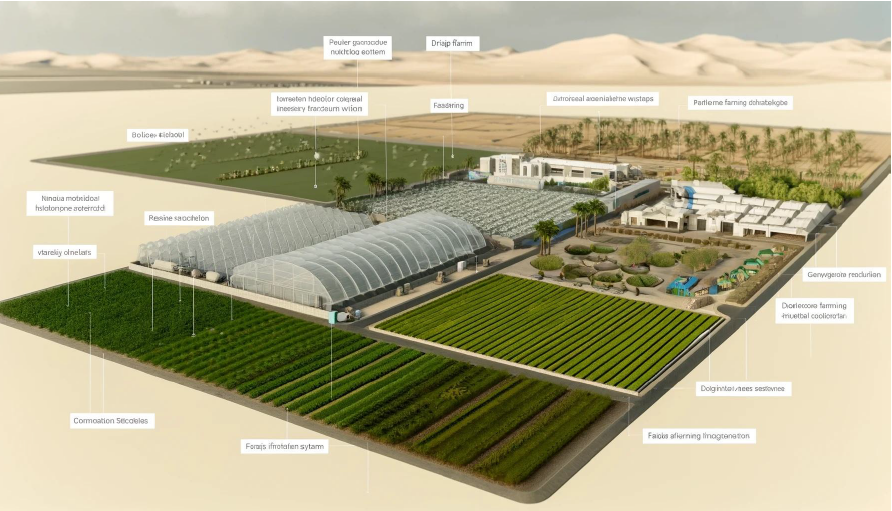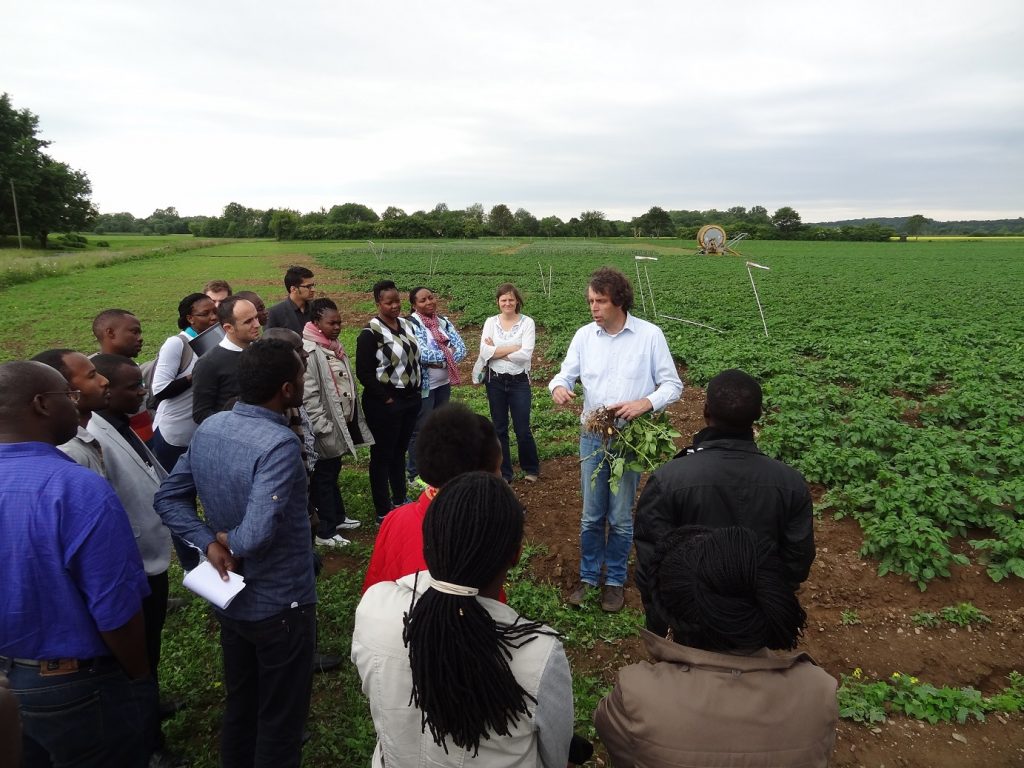Apr 19, 2024
Pilot Farms: An Innovative Approach for Sustainable Agriculture and Community Engagement

April 19, 2024 (Image: A.I. Generated)
Author: Niko Simos
The Community Impact: Education and Empowerment through Pilot Farms
In today's fast-paced world, the ever-evolving technologies and techniques in agriculture are changing at a rapid rate. Efficiency and adaptability have become paramount, driving the need for continuous learning and innovation in this field. In this dynamic scenario, pilot farms play an exceptional role. They stand as beacons of progress, serving as invaluable platforms for educating both the community and farmers. These farms act as immersive classrooms where traditional farming methods meet modern technology, and where people are equipped with the crucial knowledge needed to adapt, thrive, and sustain in our rapidly progressing agricultural landscape.
These unique agricultural hubs are becoming a revolutionary force, contributing to not just food security, but also to knowledge sharing, public education, and community empowerment. They serve as practical laboratories where investors, entrepreneurs, government bodies, and community members come together to invest in, learn, and apply innovative agricultural techniques. These initiatives are not only teaching people how to grow food, but they are also arming them with skills to navigate the future of farming, address climate change, and unlock entrepreneurial opportunities in agriculture.
What is a Pilot Farm?
The concept of pilot farms is an innovative approach to agriculture that involves setting up model farms to test and demonstrate new techniques farming, technologies, and practices. These farms serve as experimental platforms where researchers, farmers, entrepreneurs, and investors can collaborate to develop and implement sustainable farming methods.
Pilot farms play a crucial role in sustainable agriculture by providing a real-world environment for testing and refining new ideas before they are implemented on a larger scale. They allow for the assessment of the viability and effectiveness of new technologies, crop varieties, and farming practices, thereby reducing the risk associated with their widespread adoption.
For instance, picture an aquaponic farm seamlessly integrated with a vertical farm, which in turn is connected to a mushroom cultivation facility, all operating alongside an open field farm—all managed and operated by advanced robotic systems. This visionary concept brings together cutting-edge technologies and innovative farming methods, demonstrating the potential for sustainable, efficient, and interconnected agricultural systems. By consolidating these complex models into a single operational framework, pilot farms can pave the way for transformative advancements in agriculture, offering insights and solutions that can revolutionize how we cultivate food in the future.
Education and Community engagement in Pilot Farms
Moreover, Pilot farms often serve as educational centers for local communities, providing workshops and training on sustainable farming practices. They offer educational opportunities for farmers and the general public to learn about sustainable farming practices, climate-smart agriculture, and the latest developments. This helps to increase awareness and understanding of sustainable agriculture and encourages the adoption of these practices.
Furthermore, pilot farms contribute to community development by creating jobs and stimulating local economies. They promote environmental stewardship by demonstrating how farming practices can be adapted to mitigate climate change and preserve natural resources. Pilot farms stimulate local economies by creating jobs, promoting local food production, and encouraging agritourism.
Community education is a fundamental aspect of the pilot farms model. It serves as a platform for disseminating knowledge and skills about sustainable agriculture and farming practices to the local community through workshops, seminars, and hands-on training sessions conducted on-site.

(image: https://www.greenagri.org.za/events-and-workshops/)
In the pilot farms model, community education is not just about teaching farming techniques. It also involves educating the community about the importance of sustainable agriculture, its impact on the environment, and its role in ensuring food security. This holistic approach fosters a sense of responsibility and ownership among community members, encouraging them to adopt sustainable practices in their own farms.
Community education in pilot farms plays a critical role in fostering innovation. By providing a space for farmers, researchers, and community members to interact and exchange ideas, pilot farms can facilitate the development of new farming techniques and technologies. These innovations can then be tested and refined before being scaled up. By bringing together researchers, farmers, and community members, pilot farms ensure that research findings are translated into practical, on-the-ground strategies that farmers can implement.
Finally, community education in the pilot farms model contributes to community development by building the capacity of local farmers, improving their productivity and income, and leading to enhanced livelihoods and economic development in the local community.

(source: https://freshroots.ca/education/educational-farm-design/)
Funding of Pilot Farms
The key stakeholders investing in pilot farms are quite diverse, reflecting the broad interest in sustainable agriculture and community education. Government entities, private investors, and entrepreneurs often fund pilot farms as a means of supporting sustainable agriculture and community education.
Government entities are often significant investors, recognizing the potential of these farms to promote sustainable practices, boost local economies, and provide valuable educational opportunities. This includes local, state, and federal agencies, as well as international organizations dedicated to agricultural development.
Educational institutions such as universities and research institutes invest in pilot farms. They use these farms as living laboratories, conducting research on sustainable farming techniques, climate-smart agriculture, and other related topics. They also use them as teaching tools, providing students with hands-on experience in sustainable farming.
Private investors and venture capitalists also play a crucial role. They see the potential for pilot farms to generate returns while contributing to environmental sustainability and community development. These investors often have a keen interest in sustainable and impact investing, looking for opportunities that not only yield financial returns but also create positive social and environmental impact.
Entrepreneurs and businesses, particularly those in the agricultural sector, are another group of key stakeholders. They invest in pilot farms as a way to test new farming techniques, technologies, and crops, and to train their workforce in these methods. They also see the value in fostering stronger relationships with local communities and promoting sustainable farming practices.
Agricultural Concepts for Pilot Farms
These concepts are nothing short of revolutionary, encompassing everything from sustainable farming practices to cutting-edge technologies.
One of the innovative farming techniques being implemented in pilot farms is precision agriculture. This involves the use of technology such as GPS, remote sensing, and data management tools to optimize crop yields and reduce waste. It allows farmers to monitor the needs of specific areas within their fields, enabling them to apply resources like water and fertilizer more efficiently.
Another technique being introduced is vertical farming. This method of farming uses vertically stacked layers to grow crops in controlled environments. It's particularly beneficial in urban areas where space is limited. Vertical farming can also reduce water usage by up to 70% compared to traditional farming methods.
Climate-smart integrations being implemented in pilot farms include the use of renewable energy sources. For instance, some farms are installing solar panels or wind turbines to power their operations. This not only reduces the farm's carbon footprint, but can also provide a reliable source of energy in areas where the power supply may be inconsistent.
Another climate-smart integration is the use of cover crops and crop rotation. These practices can improve soil health, reduce erosion, and increase biodiversity. They can also help to sequester carbon, contributing to climate change mitigation efforts.
Finally, some pilot farms are exploring the use of aquaponics and hydroponics. These soil-less farming techniques can save water, reduce the need for pesticides, and allow for year-round production, regardless of weather conditions.
The Ultimate Goal of Pilot Farms
The main objective of pilot farms lies in education and innovation. They are conceptualized as convergence points that bring different stakeholders in agriculture—from farmers to scientists, investors to community members—together for a common purpose. They create a platform for cultivating and sharing knowledge, for exchanging ideas and strategies, for transforming challenges into opportunities.

(Image: https://rlc-blog.org/?p=1065)
At the heart of their operation, pilot farms take on the critical role of educating both industry practitioners and the public about the evolving trends of agriculture. New technologies, innovative techniques, climate-smart farming integrations, and deeper understanding of the effects of farming practices on the environment and food production, are some of the key areas addressed by their educational workshops.
Furthermore, pilot farms embrace the task of fostering creative collaborations among farmers, scientists, and other experts. These alliances are honoured as the foundation driving the development of new techniques - methods that are designed to sustain and even enhance future food production. Ahead of just keeping pace with industry advancements, pilot farms are primarily focused on achieving sustainable growth to ensure food security in the future.
Conclusion
In conclusion, pilot farms are not just testing grounds for innovative agriculture techniques; they are multi-dimensional platforms fostering education, community participation, sustainability and business enterprises. They serve as the conduit to attract investments from government, private sectors and entrepreneurs who are keen to support this transformational horizon.
They are uniquely positioned to deliver on multiple fronts.
Educationally, they empower communities and farmers with up-to-date knowledge about agriculture, farming techniques, climate-smart farming integrations, and more. They serve as the epicenter for workshops, training sessions, and demonstrations, equipping individuals with the requisite skills to thrive in agriculture.
Socially, they foster a sense of pride and belonging as community members band together to learn, grow, and invest into their shared future. Economically, they provide a fertile ground for new farm businesses to take root, with grants access, access to land, mentorship, and business training.
In the light of growing environmental concerns, pilot farms are tapping into innovative technologies like low-till farming and precision farming. These disruptive technologies play a significant role in reducing the impacts of harmful pesticides and fossil fuels while driving efficiencies for farmers.
Lastly, whether it is enabling autonomy in agriculture to counter labor shortage or deploying new renewable fertilizers, pilot farms are at the forefront of pioneering endeavors and are showing the way for the rest of the world to follow in their footsteps.
